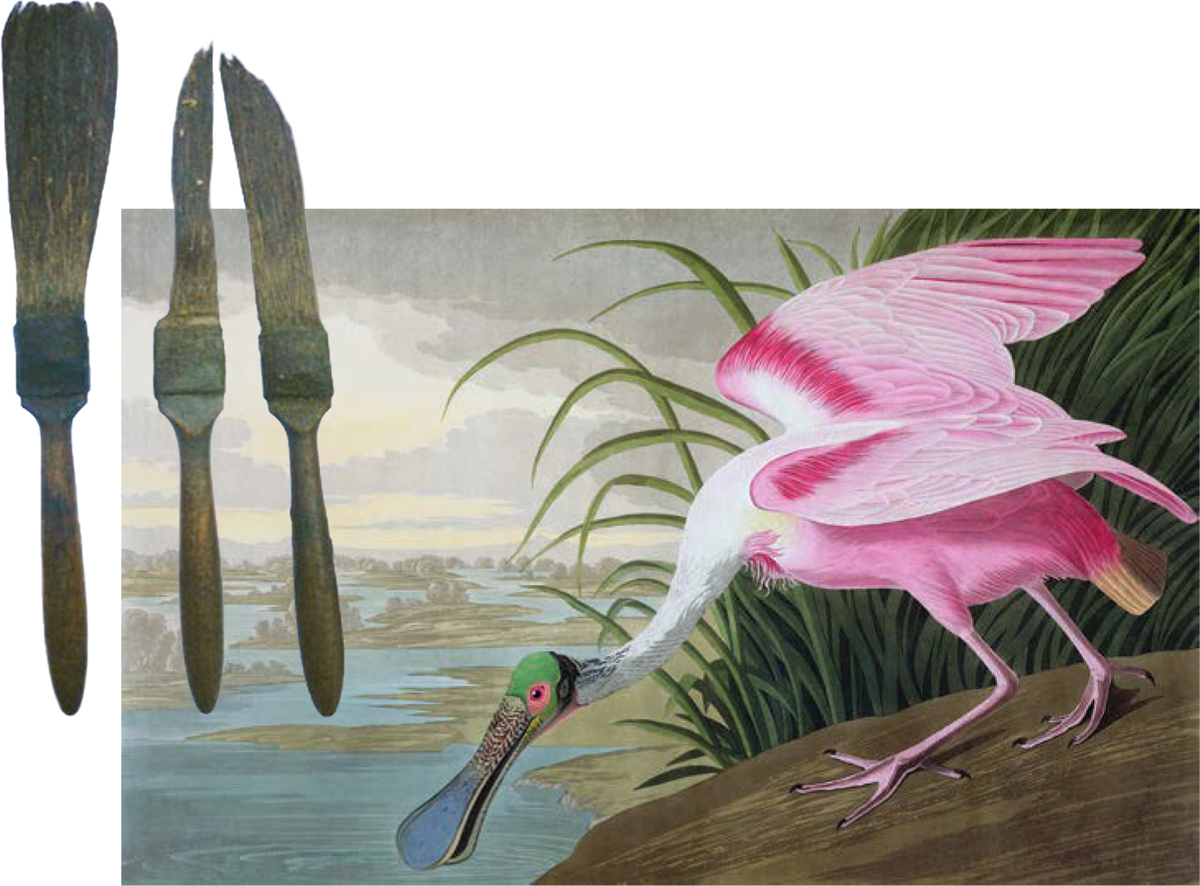
Artists like Audubon would have used handmade pig bristle brushes to capture the fine details of birds such as the Roseate Spoonbill featured in The Birds of America.
18 : Pig bristle paintbrushes
1827

Artists like Audubon would have used handmade pig bristle brushes to capture the fine details of birds such as the Roseate Spoonbill featured in The Birds of America.
While modern bird artists usually concentrate on their creative skills, perhaps combining this with a bit of birding or hobbyist natural history, for a good part of the 19th and early 20th centuries they were much more polymathic. The great bird artists of the Age of Exploration combined considerable abilities as scientists and adventurers, along with their creative capabilities.
In Britain, John Gould broke new ground in accuracy of rendition with his vibrant illustrations of Darwin’s Beagle specimens (see pages 54–55), while in North America the ambitious and dashing John James Audubon made scientific, exploration and artistic history.
At 18, being of fighting age, Audubon first entered the United States in 1803 on a false passport to avoid the Napoleonic Wars, but immediately contracted yellow fever on arrival in New York city. Placed with quakers and nursed back to health, he travelled to his family’s large homestead near Valley Forge, where he spent virtually every waking moment hunting, fishing, playing music and – significantly – drawing.
He quickly learnt a birder’s field skills, and knew that understanding weather and habitat was the key to finding and identifying birds. Avoiding a potential career in a family mining business, Audubon began to study birds almost full time. He trapped local Eastern Phoebes, tied coloured cotton threads to their legs and was able to prove that they returned to their natal site every year, after migration; in essence, he thus invented bird ringing (see pages 82–83).
Frustrated by the lack of realism seen in other artists’ depictions of America’s birds, he determined to paint them true to life. Like many well-off naturalists of his day, he had a large collection of natural objects and taught himself taxidermy and other forms of specimen preparation. The sale of a business venture then enabled Audubon to pursue his dream of painting the entire avifauna of North America full-time.
Supplementing his income by giving drawing lessons, he travelled across the continent and had soon amassed enough drawings and paintings to consider printing them as a book. Taking a portfolio of around 300 pictures, he sailed to England and raised enough money to publish his classic major work, The Birds of America (1827-1838).
His innovatory methods of creating the detailed and naturalistic paintings frequently involved 15-hour days preparing, posing and drawing his often self-collected specimens in scenes inspired by their natural habitat. Working in layered watercolour, chalk, pastels and gouache, he drew them all life-size, though he somewhat undermined the effect by contorting larger species to fit the standard paper sizes. However stylised and dramatic he made the scenes, the birds were always accurately drawn. Like most artists of his time, he also used handmade brushes of pig bristles and made his own pigments; while inconvenient, this meant he could replenish materials when travelling.
Such was the reach of his reputation after The Birds of America was published that his name became synonymous with wild birds in the USA, and America’s national bird conservation organisation the National Audubon Society was named in his honour – its founder, George Grinnell, was profoundly inspired by reading Audubon’s Ornithological Biography (1839), another major work.
Perhaps the most notable bird artist in Britain in the 19th century, Archibald Thorburn, also worked in a detailed and naturalistic fashion, creating his best-known works around the turn of the 20th century, including Christmas cards for the RSPB from 1899 onwards. Refusing to use anything other than natural light, Thorburn produced works that are still rated by modern bird illustrators as perhaps the most accurate renderings of British birds, though Gould was the undisputed prior painter of foreign birds.